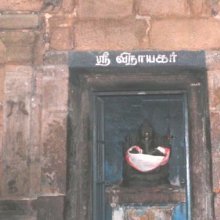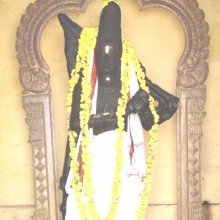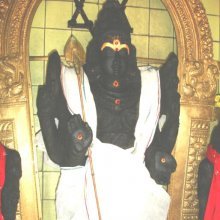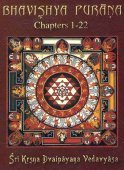Vinayaka, Vināyaka, Vināyakā: 29 definitions
Introduction:
Vinayaka means something in Buddhism, Pali, Hinduism, Sanskrit, Jainism, Prakrit, the history of ancient India, Hindi. If you want to know the exact meaning, history, etymology or English translation of this term then check out the descriptions on this page. Add your comment or reference to a book if you want to contribute to this summary article.
Alternative spellings of this word include Vinayak.
Images (photo gallery)
(+10 more images available)
In Hinduism
Purana and Itihasa (epic history)
Source: archive.org: Skanda PuranaVināyaka (विनायक).—The Skanda-purāṇa 4.2.57 gives the locations of the fifty-six Vināyakas at Kāśī (Vārāṇasī). These Vināyakas are arrayed at the eight directional points in seven concentric circles centring around Ḍhuṇḍhirāja near the Viśvanātha temple, as follows:
Circle I: (SE) Arka, (S) Durga, (SW) Bhīmacaṇḍa, (W) Dehalī, (NW) Uddaṇḍa, (N) Pāśapāṇi, (NE) Kharva, (E) Siddhi.
Circle II: (SE) Lambodara, (S) Kūṭadanta, (SW) Śālakaṭaṇṭaka, (W) Kūṣmāṇḍa, (NW) Muṇḍa, (N) Vikaṭadvija, (NE) Rājaputra, (E) Praṇava.
Circle III: (SE) Vakratuṇḍa, (S) Ekadanta, (SW) Trimukha, (W) Pañcāsya, (NW) Heramba, (N) Vighnarāja, (NE) Varada, (E) Modakapriya.
Circle IV: (SE) Abhayada, (S) Siṃhatuṇḍa, (SW) Kūṇītākṣa, (W) Kṣipraprasādana, (NW) Cintāmaṇi, (N) Dantahasta, (NE) Picaṇḍila, (E) Uddaṇḍamuṇḍa.
Circle V: (SE) Sthūladanta, (S) Kalipriya, (SW) Caturdanta, (W) Dvituṇḍa, (NW) Jyeṣṭha, (N) Gaja, (NE) Kāla, (E) Nāgeśa.
Circle VI: (SE) Maṇikarṇa, (S) Āśā, (SW) Sṛṣṭigaṇeśa, (W) Yakṣavighneśa, (NW) Gajakarṇa, (N) Citraghaṇṭa, (NE) Sthūlajaṅgha, (E) Mitra.
Circle VII: (SE) Moda, (S) Pramoda, (SW) Sumukha, (W) Durmukha, (NW) Gaṇanātha, (N) Jñāna, (NE) Dvāravighneśa, (E) Avimukta.
Ḍhuṇḍhi-vināyaka alias Ḍhuṇḍhirāja has a prime position at the centre of Kāśī. He is to be worshipped by pilgrims on entrance to Kāśī.
Source: archive.org: Puranic Encyclopedia1) Vināyaka (विनायक).—A devatā of the Gaṇas (guards of Śiva). (Mahābhārata, Anuśāsana Parva, Chapter 150, Stanza 25).
2) Vināyaka (विनायक).—Gaṇapati.
Source: archive.org: Nilamata Purana: a cultural and literary studyVināyaka (विनायक) refers to a group of deities once worshipped in ancient Kashmir (Kaśmīra) according to the Nīlamatapurāṇa.—The frequent mention of Vināyakas indicates the popularity of Vināyaka-worship in early Kaśmīra. Vināyaka appears as the giver of success in one’s undertakings and is stated to be worshipped along with his gaṇas, on the eighth day after the full-moon day of Jyeṣṭha, with heaps of sweetmeats and other eatables. Fourth day of a fortnight is prescribed for pilgrimage to Vināyaka’s temple. The verses 990-94 mention eighteen places in Kaśmīra, sacred to Gaṇeśa or Vināyaka.
Source: Cologne Digital Sanskrit Dictionaries: The Purana Index1a) Vināyaka (विनायक).—A name of Vighneśvara or Vighneśa (s.v.)1 in charge of Kailāsa hill2 a graha.3 Asked Paraśurāma not to enter Śiva's abode as he was with Umā. When he forced entry, Vināyaka made him wander all the seven worlds. Paraśurāma knocked his teeth with his axe to the enragement of Pārvatī. Śiva thought of Kṛṣṇa who appeared on the scene with Rādhā. Kṛṣṇa said that Vināyaka should be remembered on all auspicious and other occasions to bring out the desired results. The Śaiva Gaṇeśa became Vaiṣṇava:4 worshipped in all ceremonials as preliminary, in the Bhīṣma dvādaśi, in grahabali;5 when Umā made out of earth an elephantfaced doll and threw it in the Ganges, it became a huge figure, adopted as son both by Umā and Gangā; came to be known as Gāngeya and Gajānana; invested with overlordship of all Vināyakas.6 Icon of, with mūṣika mount Ṛddhi and Buddhi on either side; worship of;7 elephant shaped.8
- 1) Bhāgavata-purāṇa XI. 27. 29.
- 2) Brahmāṇḍa-purāṇa II. 25. 30.
- 3) Ib. III. 7. 161.
- 4) Ib. III. 41. 17-32, ch. 42, 44. 23.
- 5) Matsya-purāṇa 58. 26. 69. 27; 93. 16.
- 6) Ib. 154. 505; 230. 8.
- 7) Ib. 260. 19, 52-5: 261. 38: 266, 42; 269. 56; 274; 15; 289. 7.
- 8) Vāyu-purāṇa 30. 311; 54. 35; 106. 57; 109. 23.
1b) A tīrtha sacred to Umā.*
- * Matsya-purāṇa 13. 41.
2a) Vināyakā (विनायका).—A variety of evil spirits;1 a group of Bhūtas, followers of Śiva2
- 1) Bhāgavata-purāṇa II. 10. 38; VI. 8. 24; X. 2. 33; 6. 27.
- 2) Brahmāṇḍa-purāṇa II. 25. 114; III. 10. 52.
2b) Different gaṇas like Kūṣmāṇḍa, Gajatuṇḍa and Jayanta; described as having faces of lion and tiger, short and crooked, etc.1 a devagaṇa.2

The Purana (पुराण, purāṇas) refers to Sanskrit literature preserving ancient India’s vast cultural history, including historical legends, religious ceremonies, various arts and sciences. The eighteen mahapuranas total over 400,000 shlokas (metrical couplets) and date to at least several centuries BCE.
Dharmashastra (religious law)
Source: archive.org: The religion and philosophy of the Veda and the Upanishads (dharmashastra)Vināyaka (विनायक) is the name of a deity to be invoked in a certain ritual, according to the Mānavagṛhyasūtra 2.14. Accordingly, the deity is prescribed when one suffers from possession by the Vināyakas, Śālakaṭaṅkaṭa, Kūṣmāṇḍarājaputra, Usmita and Devayajana. The Baijavāpagṛhyasūtra replaces the names of last two vināyakas with Mita and Sammita. According to R. C. Hazra in his Gaṇapati-worship, “this rite is both expiatory and propitiatory in nature and in which various things including meat and fish (both raw and cooked) and wine and cakes are to be offered”..
The gṛhya-sūtras are a branch of dharma-sūtras and refer to a category of Vedic literature dealing with domstic rites and rituals. The Mānava-gṛhya-sūtra belongs to the Kṛṣṇa-yajurveda. The Baijavāpa-gṛhya-sūtra is known only through references to it in other works (e.g., Vīramitrodaya-Saṃskāra).
Source: archive.org: History Of Dharmasastra Vol II Part IVināyaka (विनायक).—The Baijavāpa-gṛhya (quoted by Aparārka p.563 on Yāj. I.275) says that there are four Vināyakas:—Mita, Sammita, Sālakaṭaṅkaṭa and Kuṣmāṇḍa-rāja-putra and describes seizure by them and its effects in the same way as the Mānava-gṛhya. These two show the first stage in the development of the cult of Vināyaka. Vināyakas are at this stage malevolent spirits who cause dangers and obstacles of various kinds. In this cult various elements from the terrific aspects of Rudra were probably first drawn upon and amalgamated with oth er elements drawn from aboriginal cults

Dharmashastra (धर्मशास्त्र, dharmaśāstra) contains the instructions (shastra) regarding religious conduct of livelihood (dharma), ceremonies, jurisprudence (study of law) and more. It is categorized as smriti, an important and authoritative selection of books dealing with the Hindu lifestyle.
Shilpashastra (iconography)
Source: Shodhganga: The significance of the mūla-beras (śilpa)Vināyaka (विनायक) has the face of an elephant, three eyes, a fat body, protruding stomach and short limbs. According to the form, different kinds of implements are held in his many hands. The image is found in standing, seated, or dancing posture. The standing posture of Vināyaka is appropriate for processions as utsava mūrti. In the garbhagṛhas, the seated form is consecrated for worship. The structural implications are studied with regard to the standing Vināyaka, Vināyaka image in a flexed posture and Vināyaka in āsana or seated posture.
The image of Vināyaka in uttama-pañcatāla exemplifies both profound spiritual meaning and artistic creativity. Vināyaka is commonly found with four hands. The miniature form of the deity is so attractive and appealing to the viewers. Each form is of artistic beauty. There are Vināyakas with five pairs of hands. Instead of depicting in dance the usual kapittha-hastas denoting the paśa and the aṅkuśa; Vināyaka can be shown with other hastas denoting the other attributes that are discussed in the study of the Vināyaka at the Nellaiappar Temple in Tirunelveli. [...] He is found with ghaṇṭa or bell in one of his hands, which denotes the symbol of auspiciousness.
Vināyaka is depicted in various Temples:—
The Arunachaleswara Temple (Aruṇācaleśvar) in Thiruvannamalai (Tiruvaṇṇāmalai), [Śiva temple].—Vināyaka is found in lalitāsana posture. He has four arms [...].
The Thillai Nataraja Temple in Cidambaram (Chidambaram), [another Śiva temple].—In the sannidhi for Vināyaka, the deity is seated in lalitāsana and the other attributes are the same as discussed earlier. There is another sannidhi for Tirumūla Vināyaka where Vināyaka is found in sukhāsana posture with the attributes remaining the same. It is rare to find Vināyaka in sukhāsana posture because he is mostly found in lalitāsana posture and samapāda-sthānaka. But, in the Tillai Naṭarāja Temple, there is a Vināyaka by name Tirumūla Vināyaka in sukhāsana posture.
The Nellaiappar Temple at Tirunelveli, [another Śiva temple].—Vināyaka is found to the left as well as right of Subrahmaṇya’s sannidhi. The Vināyaka seen on the left of Subrahmaṇya’s sannidhi is seated in lalitāsana with the left leg folded on the pedestal and the right leg bent with the sole firmly placed down. [...] He has four arms [...].
The Kamakshi Amman Temple in Kanchipuram, [Devī or Goddess temple].—Vināyaka is represented as seated with the left leg folded. [...] In iconography, he is represented in lalitāsana posture.
The Subramanya Swamy Temple (or Subrahmaṇya Svāmi Temple) in Tiruchendur (or Tirucendur/Tirucentur), [Murugan temple].—Vināyaka is found in lalitāsana with four hands as usual. A specialty is that Siddhi, the wife of Vināyaka, is found seated on his left thigh.
Another Subramanya Swamy Temple in Thiruparankundram or Parankundram (Paraṅkuṉṟam), [Murugan temple].—Vināyaka is represented as seated in lalitāsana pose with four hands [...] Then comes the Tiruvātcī Maṇḍ apa. There is a teppakulam (a holy pond found in most temples) and to the right of the teppakulam is Siddhi Vināyaka. Siddhi Vināyaka is represented with four hands.

Shilpashastra (शिल्पशास्त्र, śilpaśāstra) represents the ancient Indian science (shastra) of creative arts (shilpa) such as sculpture, iconography and painting. Closely related to Vastushastra (architecture), they often share the same literature.
General definition (in Hinduism)
Source: Wisdom Library: HinduismVināyakā (विनायका, “queen of knowledge”):—Another name for Unnati (the wife of Garuḍa), acording to the Purāṇas.
Source: Google Books: Banaras: Making of India’s Heritage CityVināyaka (विनायक).—The total number of vināyakas is 56. It refers to the divine guardian concept. The guardian deity (Śiva, or Gaṇeśa/ Vināyaka) at the junction of eight cardinal directions in all the seven layers of the atmosphere (8x7) protects human being from obstacles. This in itself presents a model of the cosmos.
Gaṇeśa/ Vināyaka, with his 56 forms, protects the dwellers or visitors to this city (Kāśī, Vārāṇasī) from obstacles at eight cardinal directions in all the seven layers of the realm between earth and heaven (symbolically representing seven layers of the atmosphere). They serve as lokapala, the directional guardians of the universe who reside at all the cardinal junctions. The number and location of 56 vināyakas can be represented in a spatio-cosmological model showing the eight directions, seven layers, three sacred segments of Vārāṇasī and the interlinking routes of pilgrimage journeys in sprial form.
The sequential arrangement of 56 vināyakas, is arranged in a model as described in the mythologies and followed by the pilgrims performing the sacred journey. The arrangement symbolises the concept of universe within universe, i.e., interconnecting macrocosmos, mesocosmos, and microcosmos. This can be experienced and revealed only by eternal sense, soul—a subject beyond the bodily experience; it is the complement of spiritual experience which some of the pilgrims receive, of course there is no language for expressing the ultimate nature of revelation and eternal experience.
Source: Shodhganga: The significance of the mūla-berasVināyaka (विनायक), the older son of Śiva and Pārvatī, is called by several names such as Gaṇeśa, Gaṇapati, Oṃkārasvarūpa and Modakapiriyan (also, Pillayār, Vighneśvara, Ānaimukavar, Gajānana, and Tumbikkaiyan). The image of Vināyaka is the most elegant expression of the metaphysical quality of the scared Oṃ, the fundamental sound and the origin of all other sounds. The written form of the Oṃ sound in Tamil is similar to the face of Vināyaka. Oṃ stands for the absolute substance, the entire universe, and the essence of all Vedas. Oṃ is the Brahman from which all creation begins and into which all return. [...]
Vināyaka is thus compared to the praṇava-mantra Oṃ. As Oṃ stands for the Brahman from which all creation begins, Vināyaka is also worshipped first in temples by the devotees. The first invocation is always directed to him before any work is initiated; and then, the devotees think of offering their prayers and sacrifices to Vināyaka. As the image of Vināyaka is considered as a form of the saguṇa-brahman, it embodies the unique and unequalled qualities of the Supreme Being who carries out the three tasks of creation, protection and dissolution.
Vināyaka’s three eyes show that he is conceived as an embodiment Śiva himself. The modaka stands for the world of reality. Hence, it is believed that Vināyaka bears the weight of reality and also protects and nurtures it. Since the letter Oṃ represents the protective aspect of the divine being, Vin āyaka is held in great regard and worshipped by those who seek good things in life.
Vināyaka is found with ghaṇṭa or bell in one of his hands, which denotes the symbol of auspiciousness. It is said that Sarasvatī resides in its tongue, Brahma in its face, Rudra in its belly, Vāsuki in its stem with its entire body signifying the divinity of time. Its handle denotes the prāṇa-śakti (vital force). The metal bells, when struck, reverberate the sound oṃ. It is believed to dispel all demoniac feelings within the devotee and infuse in him/her with divine bliss. It is also believed that the bell and its sound pleases the god and mitigates the devotee from the fear of birth and death.
In Buddhism
Tibetan Buddhism (Vajrayana or tantric Buddhism)
Source: academia.edu: A Critical Study of the Vajraḍākamahātantrarāja (II)Vināyakā (विनायका) refers to one the twenty-four Horā (astronomical) Goddess to be invoked during pūjā (ritual offering) in Tantric Buddhism, according to the 9th-century Vajraḍākatantra chapter 18.61-74. [...] A Yogin, putting a vessel in the left side of him, offers various things together with raw flesh, fish, immortal nectar (pañcāmṛta). Then the Yogin invites Goddesses to please them with nectar—five Ḍākinīs and twenty-four Goddesses [viz., Vināyakā] come to the Yogin’s place, forming a maṇḍala.
Source: OSU Press: Cakrasamvara SamadhiVināyaka (विनायक) refers to the “leader (of all obstacles)”, according to the Guru Mandala Worship (maṇḍalārcana) ritual often performed in combination with the Cakrasaṃvara Samādhi, which refers to the primary pūjā and sādhanā practice of Newah Mahāyāna-Vajrayāna Buddhists in Nepal.—Accordingly, “oṃ amṛta-kuṇḍalī kha kha khāhi khāhi tiṣṭha tiṣṭha bandha bandha hana hana daha daha paca paca garja garja visphoṭaya visphoṭaya sarvavighnavināyakānāṃ mahāgaṇapatijīvitāntakarāya hūṃ hūṃ phaṭ phaṭ svāhā!”.

Tibetan Buddhism includes schools such as Nyingma, Kadampa, Kagyu and Gelug. Their primary canon of literature is divided in two broad categories: The Kangyur, which consists of Buddha’s words, and the Tengyur, which includes commentaries from various sources. Esotericism and tantra techniques (vajrayāna) are collected indepently.
In Jainism
General definition (in Jainism)
Source: Wisdom Library: JainismVināyaka (विनायक) is the name of a class of rākṣasas according to both the Digambara and the Śvetāmbara traditions. The rākṣasas refer to a category of vyantaras gods which represents one of the four classes of celestial beings (devas). The rākṣasas are black and their caitya-vṛkṣas (sacred-tree) is Kaṇṭaka according to the Digambara They are white and have a fierce appearance according to Śvetāmbara.
The deities such as the Vināyakas are defined in ancient Jain cosmological texts such as the Saṃgrahaṇīratna in the Śvetāmbara tradition or the Tiloyapaṇṇati by Yativṛṣabha (5th century) in the Digambara tradition.

Jainism is an Indian religion of Dharma whose doctrine revolves around harmlessness (ahimsa) towards every living being. The two major branches (Digambara and Svetambara) of Jainism stimulate self-control (or, shramana, ‘self-reliance’) and spiritual development through a path of peace for the soul to progess to the ultimate goal.
India history and geography
Source: Project Gutenberg: Castes and Tribes of Southern India, Volume 1Vinayaka (“ganesa”) refers to one of the gotras (clans) among the Medaras: workers in bamboo in the Telugu, Canarese, Oriya and Tamil countries. The Medara people believe that they came from Mahendrachala mountain, the mountain of Indra. They are also known as the Meda, Medarlu or Medarakaran.
Source: Cologne Digital Sanskrit Dictionaries: Indian Epigraphical GlossaryVināyaka.—(LL), a teacher of the vinaya texts; a name of the god Gaṇeśa. Note: vināyaka is defined in the “Indian epigraphical glossary” as it can be found on ancient inscriptions commonly written in Sanskrit, Prakrit or Dravidian languages.

The history of India traces the identification of countries, villages, towns and other regions of India, as well as mythology, zoology, royal dynasties, rulers, tribes, local festivities and traditions and regional languages. Ancient India enjoyed religious freedom and encourages the path of Dharma, a concept common to Buddhism, Hinduism, and Jainism.
Languages of India and abroad
Pali-English dictionary
Source: BuddhaSasana: Concise Pali-English Dictionaryvināyaka : (m.) a great leader; the Buddha.
Source: Sutta: The Pali Text Society's Pali-English DictionaryVināyaka, (fr. vi+nī) 1. a leader, guide, instructor M. II, 94; Vv 167 (=veneyya-satte vineti VvA. 83); ThA. 69. ‹-› 2. a judge J. III, 336. (Page 624)

Pali is the language of the Tipiṭaka, which is the sacred canon of Theravāda Buddhism and contains much of the Buddha’s speech. Closeley related to Sanskrit, both languages are used interchangeably between religions.
Sanskrit dictionary
Source: DDSA: The practical Sanskrit-English dictionaryVināyaka (विनायक).—
1) A remover (of obstacles).
2) Name of Gaṇeśa; विनायकं प्रकुर्वाणो रचयामास वानरम् (vināyakaṃ prakurvāṇo racayāmāsa vānaram) Subhāṣ.
3) A Buddhist deified teacher.
4) Name of Garuḍa.
5) An obstacle, impediment.
6) A spiritual preceptor.
7) A leader, guide.
Derivable forms: vināyakaḥ (विनायकः).
Source: Cologne Digital Sanskrit Dictionaries: Edgerton Buddhist Hybrid Sanskrit DictionaryVināyaka (विनायक).—(= Pali id.), common epithet of a Buddha, either guide, leader, or trainer, discipliner (compare Pali Vimānavatthu (Pali) commentary 83.18 veneyyasatte vinetī ti vināyako): Mahāvyutpatti 22 (Tibetan rnam par ḥdren pa); Lalitavistara 437.12, 14; Divyāvadāna 166.26, et passim.
Source: Cologne Digital Sanskrit Dictionaries: Shabda-Sagara Sanskrit-English DictionaryVināyaka (विनायक).—m.
(-kaḥ) 1. A Bud'dha, a Baud'dha, deified teacher. 2. Gane- Sa. 3. Garuda, the bird and vehicle of Vishnu. 4. A Guru, or spiritual preceptor. 5. An obstacle, an impediment or difficulty. f.
(-yikā) The wife of Garuda. E. vi before, nī to conduct, aff. ṇvul .
Source: Cologne Digital Sanskrit Dictionaries: Benfey Sanskrit-English DictionaryVināyaka (विनायक).—i. e. vi-nī + aka, I. m. 1. A spiritual teacher. 2. Gaṇeśa, [Lassen, Anthologia Sanskritica.] 1, 1. 3. Garuḍa. 4. An obstacle. Ii. f. yikā, The wife of Garuḍa.
Source: Cologne Digital Sanskrit Dictionaries: Cappeller Sanskrit-English DictionaryVināyaka (विनायक).—[masculine] guide, conduct; [Epithet] of Ganeśa, [plural] a class of demons.
Source: Cologne Digital Sanskrit Dictionaries: Aufrecht Catalogus Catalogorum1) Vināyaka (विनायक) as mentioned in Aufrecht’s Catalogus Catalogorum:—guru of Govinda (Śāṅkhāyanamahāvratabhāṣya). W. p. 28.
2) Vināyaka (विनायक):—one of the 6 gurus of Ṣaḍguruśiṣya. W. p. 12.
3) Vināyaka (विनायक):—father of Rāmadāsa (Prabodhacandrodayaṭīkā).
4) Vināyaka (विनायक):—Tithiprakaraṇa jy. Burnell. 79^b.
5) Vināyaka (विनायक):—Mantrakośa.
6) Vināyaka (विनायक):—Virahiṇīmanovinoda.
7) Vināyaka (विनायक):—Vaidikachandaḥprakāśa.
8) Vināyaka (विनायक):—of the Maladharavaṃśa, father of Ananta (Śabdasudhā).
9) Vināyaka (विनायक):—son of Jayadeva: Cakroddhārasāra jy.
10) Vināyaka (विनायक):—Daśakumāracaritapūrvapīṭhikā.
Source: Cologne Digital Sanskrit Dictionaries: Monier-Williams Sanskrit-English Dictionary1) Vināyaka (विनायक):—[=vi-nāyaka] a etc. See under vi-√nī.
2) [=vi-nāyaka] [from vi-nī] b mf(ikā)n. taking away, removing, [Monier-Williams’ Sanskrit-English Dictionary]
3) [v.s. ...] m. ‘Remover (of obstacles)’, Name of Gaṇeśa, [Yājñavalkya; Varāha-mihira’s Bṛhat-saṃhitā] etc.
4) [v.s. ...] a leader, guide, [Mahābhārata; Rāmāyaṇa]
5) [v.s. ...] a Guru or spiritual preceptor, [cf. Lexicographers, esp. such as amarasiṃha, halāyudha, hemacandra, etc.]
6) [v.s. ...] a Buddha, [cf. Lexicographers, esp. such as amarasiṃha, halāyudha, hemacandra, etc.]
7) [v.s. ...] Name of Garuḍa, [cf. Lexicographers, esp. such as amarasiṃha, halāyudha, hemacandra, etc.]
8) [v.s. ...] an obstacle, impediment, [cf. Lexicographers, esp. such as amarasiṃha, halāyudha, hemacandra, etc.]
9) [v.s. ...] = anātha (?), [cf. Lexicographers, esp. such as amarasiṃha, halāyudha, hemacandra, etc.]
10) [v.s. ...] Name of various authors etc., [Catalogue(s)]
11) [v.s. ...] m. [plural] a [particular] class of demons, [Mānava-gṛhya-sūtra; Mahābhārata] etc.
12) [v.s. ...] m. [plural] Name of [particular] formulas recited over weapons, [Rāmāyaṇa]
Source: Cologne Digital Sanskrit Dictionaries: Yates Sanskrit-English DictionaryVināyaka (विनायक):—[vi-nāyaka] (kaḥ) 1. m. A Buddha; Ganesha; Garuḍa; a guru; an obstacle. f. kiyā Wife of Garuḍa.
Source: DDSA: Paia-sadda-mahannavo; a comprehensive Prakrit Hindi dictionary (S)Vināyaka (विनायक) in the Sanskrit language is related to the Prakrit word: Viṇāyaga.
[Sanskrit to German]
Sanskrit, also spelled संस्कृतम् (saṃskṛtam), is an ancient language of India commonly seen as the grandmother of the Indo-European language family (even English!). Closely allied with Prakrit and Pali, Sanskrit is more exhaustive in both grammar and terms and has the most extensive collection of literature in the world, greatly surpassing its sister-languages Greek and Latin.
Hindi dictionary
Source: DDSA: A practical Hindi-English dictionaryVināyaka (विनायक) [Also spelled vinayak]:—(nm) the god Ganesh.
...
Kannada-English dictionary
Source: Alar: Kannada-English corpusVināyaka (ವಿನಾಯಕ):—
1) [noun] the act or removing, taking away.
2) [noun] a leader; a guide.
3) [noun] he who wards of obstructions, impediments.
4) [noun] Gaṇēśa, the chief of Gaṇas, attendants of Śiva.
5) [noun] Garuḍa, the king of birds.
6) [noun] an obstacle; an impediment.
7) [noun] the Buddha.
Kannada is a Dravidian language (as opposed to the Indo-European language family) mainly spoken in the southwestern region of India.
See also (Relevant definitions)
Starts with (+22): Vinayaka bhatta, Vinayaka Chaturthi, Vinayaka pandita, Vinayaka-homa, Vinayakabhatta, Vinayakabhojanavarnana, Vinayakacarita, Vinayakacaturthi, Vinayakacaturthivrata, Vinayakacaturtti, Vinayakacauti, Vinayakacavutti, Vinayakachaturthi, Vinayakadvadashanamastotra, Vinayakamahatmya, Vinayakamahatmyatika, Vinayakantakshepa, Vinayakapandita, Vinayakapujavidhi, Vinayakapura.
Ends with (+49): Abhayadavinayaka, Arkavinayaka, Ashavinayaka, Ashtavinayaka, Avimuktavinayaka, Bhairavinayaka, Bhatta vinayaka, Bhimacandavinayaka, Bhimachandavinayaka, Bhutavinayaka, Caturdantavinayaka, Chaturdantavinayaka, Chintamanivinayaka, Chitraghantavinayaka, Cintamanivinayaka, Citraghantavinayaka, Dantahastavinayaka, Dehalivinayaka, Durgavinayaka, Durmukhavinayaka.
Full-text (+453): Vainayaka, Siddhivinayaka, Vighnavinayaka, Vinayakashanti, Dhundhiraja, Vinayakacaturthi, Vinayakapurana, Vinayakacaturthivrata, Vinayakabhatta, Vinayakapujavidhi, Vinayakadvadashanamastotra, Vinayakasamhita, Vinayakasahasranaman, Vinayakamahatmya, Vinayakavratakalpa, Vinayakavratapuja, Vinayakashantipaddhati, Vinayakashantiprayoga, Vinayakashantisamgraha, Vinayakastavaraja.
Relevant text
Search found 71 books and stories containing Vinayaka, Vi-nayaka, Vi-nāyaka, Vināyaka, Vināyakā; (plurals include: Vinayakas, nayakas, nāyakas, Vināyakas, Vināyakās). You can also click to the full overview containing English textual excerpts. Below are direct links for the most relevant articles:
The Skanda Purana (by G. V. Tagare)
Chapter 57 - Manifestation of Dhuṇḍhi Vināyaka and Fifty-six Vināyakas < [Section 2 - Uttarārdha]
Chapter 100h - Antargṛha Yātrā < [Section 2 - Uttarārdha]
Chapter 309 - Greatness of Four-Faced Vināyaka < [Section 1 - Prabhāsa-kṣetra-māhātmya]
The Garuda Purana (by Manmatha Nath Dutt)
Chapter C - Worship of Vinayakas Durga < [Agastya Samhita]
Chapter CXXIX - The Pratipad Vratas < [Brihaspati (Nitisara) Samhita]
Chapter V - Creation of the Prajapatis < [Agastya Samhita]
Chaitanya Bhagavata (by Bhumipati Dāsa)
Verse 2.18.149 < [Chapter 18 - Mahāprabhu’s Dancing as a Gopī]
Bhagavatpadabhyudaya by Lakshmana Suri (study) (by Lathika M. P.)
The Greatness of Guru and Manisha Panchakam < [Chapter 3 - References to Śaṅkara’s Philosophy]
Cosmology and the powers of Māya < [Chapter 3 - References to Śaṅkara’s Philosophy]
Amarakoshodghatana of Kshirasvamin (study) (by A. Yamuna Devi)
Gods and Divinities < [Chapter 4 - Cultural Aspects]
Harshacharita (socio-cultural Study) (by Mrs. Nandita Sarmah)
9. Religious Cults < [Chapter 6 - Other Socio-Cultural Aspects]
Related products








